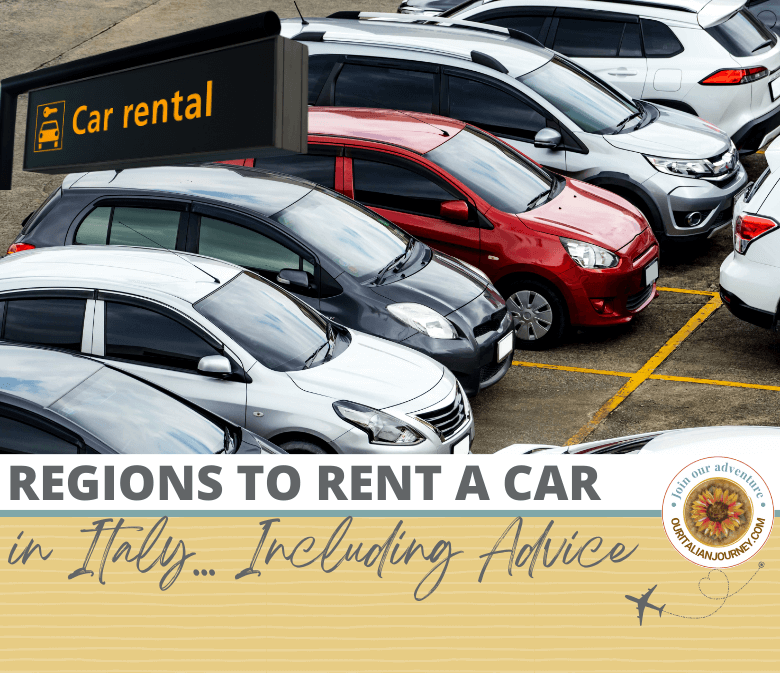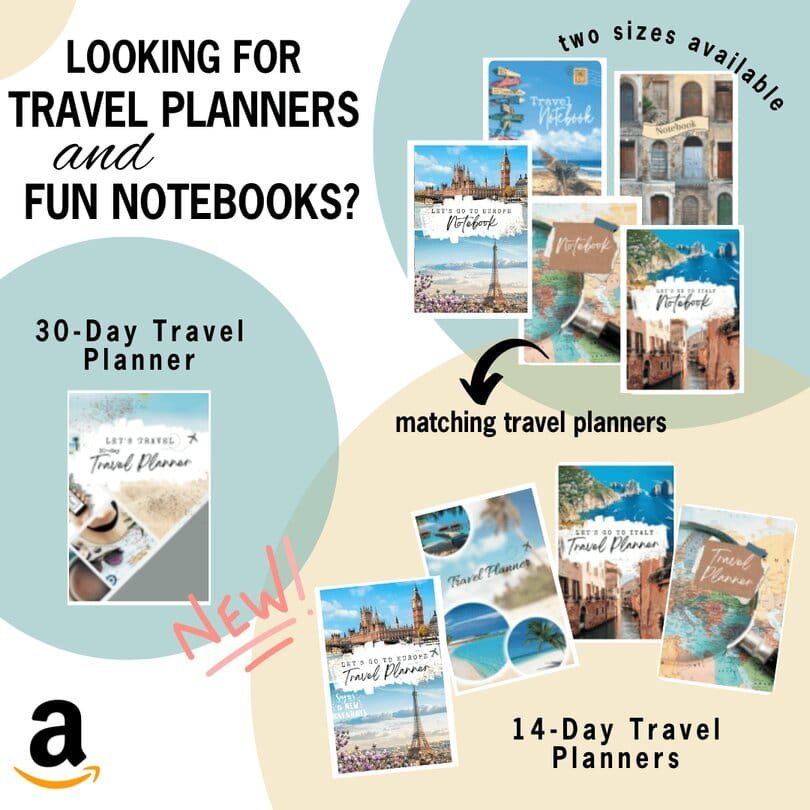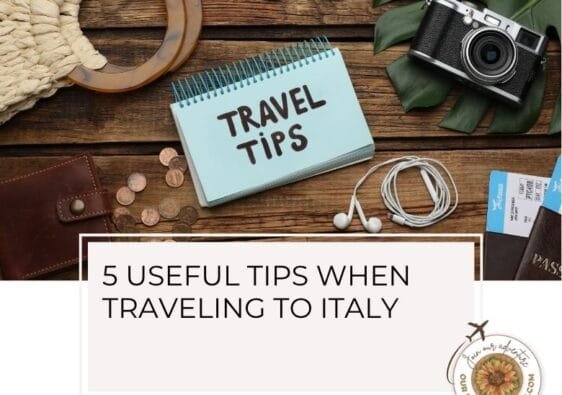So… You’re booked and ready to travel… are you thinking, “Should I rent a car?” Read on and perhaps we can help you decide whether you should.
This post contains affiliate links that help keep this website running. By purchasing through our links, we make a small commission at no extra charge to you. Thank you for your support!
My purpose in this post is to help you decide whether or not to rent a car in Italy and also explain which areas or regions in this beautiful country might not be easily accessible using public transportation. You know we enjoy traveling by train… but, at times, it has limitations. Keep in mind… if you’re visiting both cities and the countryside, perhaps you might need to rent a car just for when you visit the countryside.
First and Foremost… Car Rental Companies
We have used the following companies with no issues. Gary handles this part of our trip and he will always check all three sites as sometimes he gets different pricing. Ya never know. We do not get any compensation for mentioning them – just giving you our experience.
You might ask what documents you’ll need to rent a car:
- If you’re a non-EU citizen it’s essential to hold an International Driver’s Permit. The Italian car rental might not ask for it, but it is required by law that you have one. If pulled over by the poliza, more than likely you will be requested to show it.
- Your driver’s license from your home country
- Your ID (passport)
- Credit Card
- The legal driving age in Italy is 18 years old. However, you need to have had your driver’s license for at least one year. Generally, rental car companies in Italy require you to be 21 or over. Note, that most car rentals in Italy charge an extra fee if you’re under 25.
Good to Know
These days you can rent electric cars but things are not quite as up-to-date here in Italy as, let’s say, the States. There are significantly fewer networks of charge stations. They may be a great option in your country – but not here in Italy. But that’s my opinion.
Toll Booths on the Autostrada
There are now more ways to pay other than cash on the autostrada but… avoid the chaos and make sure you choose the correct lane. Most, if not all toll booths are unmanaged in Italy. You will perhaps see a person up in the main building, but not in the individual booths that you pull through. Credit cards and even Apple Pay are some of the contactless payment methods accepted at many of the toll booths these days.

Italian law requires you to have an anti-abandonment device which you can rent from the car rental agency. The car rental will not require you to rent one – but it is a law in Italy. You can always still rent a car seat or bring your own.
Pros and Cons of Renting a Car
| PROS | CONS |
| Ultimate freedom to visit out-of-the-way places | Gas is more expensive in Italy |
| Easier/less expensive with larger groups | May still need public transportation at destination |
| With children more flexible bathroom breaks | Tolls can be expensive |
| Versatile travel schedule | Pesky ZTL Zones |
| Parking can be difficult |
Compass Areas
In the Northern Regions
Yes… I would suggest that you rent a car in the regions: Aosta Valley, Friuli-Venezia Giulia, Liguria, Piemonte, Trentino Alto Adige, and Veneto. It’s possible, but more difficult to get around by public transportation. In Lombardy, you could get away without a car rental especially if you are visiting the lakes of Como and Garda from Milan but know that once at your destination, you will need a bus or taxi.
No… if specifically visiting the Cinque Terre. These five small villages (Corniglia, Monterosso al Mare, Manarola, Riomaggiore, and Vernazza.) Parking is possible in La Spezia just south of these towns but within the Cinque Terre, there is a fantastic train to take you to all of these towns.
Renting a car is a must if you are interested in visiting wineries – especially in Alba, Asti, and Barolo. Vineyards and wineries are often only accessible by car.
In the Central Regions
I would suggest that YES… you rent a car when visiting: Abruzzo, Emilia-Romagna, Lazia, Marche, Molise, Tuscany, and Umbria. Now, I will say that it is easy to travel by train from some of these regions to others. My disclaimer would be that we have yet to explore Abruzzo, Marche, and Molise so I am a bit unfamiliar with the infrastructure in these areas.
YES especially if you are planning to visit some hilltowns in Tuscany: Cortona, San Gimignano, Montepulciano, and Siena. YES if you are going to enjoy the vineyards in Chianti. Tour buses are another option if perhaps you are staying in Florence and want to visit these towns.
NO, if you want to use the train in Emilia-Romagna. When we stayed in Parma for 90-days, we loved this train line and could easily go to Bologna and Modena.
If visiting the Amalfi Coast… NO. New laws have reduced the amount of cars allowed on the beautiful winding roads of the Amalfi Coast in the summer. It is truly best to enjoy this area with a tour or private tour guide.
Make sure you know about driving into the historic center of any town. Our post on ZTL Zones and what it means might be important information you should know!
In the Southern Regions
YES for the regions: Basilicata, Calabria, Campania, and Puglia. Although we haven’t yet visited Calabria and Campania, there is very little public transportation available in these regions. Busses will always be a viable option in any small town. In Puglia, there is a great train line from Bari down to Lecce.
In Sardinia and Sicily
YES for both these islands – especially Sicily. To enjoy all of Sardinia, explore by car or Vespa. Just a thought… check to make sure you can take your rental on the ferry to both islands. Although there is a train line in Sicily, you almost must rent a car to get anywhere.
Conclusion
Bottom line… it comes down to where you are planning to visit. As mentioned above, perhaps you only need to rent a car for part of your visit – not the entire time. Plan wisely, make good use of your time, and enjoy this beautiful country.











We’ve been to Le Marche and Umbria several times and found that a car is essential. In Le Marche, the train service is along the coast, so if you want to explore inland areas, you will want a car. Similarly, exploring the hill towns in Umbria will require a car. (Even though we love both regions, the necessity of a car was a factor in choosing to settle in Lucca instead, as I don’t plan to drive in Italy, although my husband will.)
I completely agree that you don’t want a car on the Amalfi Coast. Although my husband has driven in Italy for nearly 35 years, even he was uncomfortable driving there. We used buses frequently when we were there. We often stayed in our favorite town, Ravello, and generally walked down to Minori, Atrani, and Amalfi, but took the bus uphill on the way back.
Thank you Lisa for the informative comment. When do you plan on settling in Lucca? Please email us and let’s connect privately!
Thanks Ilene! Great information as always! I pinned this post!
Thanks Teresa – happy is was informative for you. Please share with friends and family!
We have rented a car in Italy each of the last 3 years. In 2022 it was only for 24 hours the get us from Venice to Lake Como (Moltrasio) with an overnight in Sirmione on Lake Garda. We had a day on our own between a Viking ocean cruise and a Viking river cruise. That was my first time driving in Italy and it gave me the confidence to do it again. Last spring we rented a car for a month, and again this year for 4 weeks, both times in and out of Milan. Being from the U.S., we felt comfortable renting from an American company and we did the first rental with Avis, the second two with Hertz. The two Hertz rentals were through AAA travel and all 3 worked well. Note that you have to get your international driving permit before you arrive in Europe; you can get it at a AAA office in the U.S. Our last two trips covered almost 3,000km each and I had no problem, other than an accidental ZTL violation in Greve in Chianti and two speeding tickets in Iseo. The speeding tickets were only 6 and 8 km over (less than 5MPH), so watch your speed! If your hotel is in a ZTL, be sure that you arrange with the hotel for permission to enter the ZTL. When you reserve your hotel, make sure they have parking available and let them know that you will be driving. Before you arrive to enter the ZTL, contact them so you can give them the car license plate number to get you authorized to enter the ZTL. We enjoy road trips, as they allow you to get out to places that are too difficult without a car. Last year our basic itinerary was Lake Orta (with a day trip to Lake Maggiore) – Lucca (sorry we missed you) – Florence – Greve in Chianti – San Marino – Venice – Riva del Garda – Iseo – Sirmione and back to Orta San Giulio. We were going to spend our last two days in Milan, but fell in love with Lake Orta and went back there. This year, our basic itinerary was Lake Como (Moltrasio) – Florence – Assisi – a stop at the Ferrari Museum in Maranello – Venice – Lago di Braies in the Dolomites – Hall in Tirol, Austria – Grindelwald Switzerland – Gunten Switzerland – Montreux Switzerland – Annecy France and then through the Aosta Valley back to Milan. When you are in a city like Florence, you will leave the car in the parking garage most of the time, but it’s available if you want to do some exploring outside of the city. On our last two trips we got to places that would be difficult or impossible without a car. We are in the early stages of planning our next European road trip now; it’s a great way to see Europe. Something to be aware of if you venture outside of Italy, is that many (most?) European countries require a special permit if you drive there, so do your research before you leave home if you are going to venture beyond Italy. We got our Swiss permit online and our Austrian permit at the border as we entered Austria. Also, most fuel (gas and diesel) stations are unattended on Saturday and Sunday and many require a PIN for your credit card. Another tip, is only get a car big enough for you and your luggage, as the roads are narrower than in the U.S., especially in most cities, and a smaller car makes it much easier, as well as using less fuel.
Thank you Dennis for the detailed comment. I’m sure our readers will appreciate the extra information and your experiences. You make several great points – especially about the hotel in a ZTL zone. It is important to know this ahead of time! Thanks again!
In Abruzzo I would think a car is a must. There is train service along the coast through Pescara. But inland it is not so good. There are buses. On my trip I took a taxi from Fiumicino to Atessa, not cheap, all on four lane roads until we got to town. In town there is a parking garage which is free. Atessa is very walkable so you don’t need the wheels. To go exploring elsewhere like the Trabocchi coast or Gran Sasso you would need a car.
Thank you Jeff – we haven’t gotten to Abruzzo yet (crazy I know) but you are 100% correct that its a must. Thanks for the great info for our readers!!